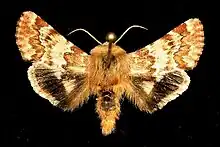Schinia septentrionalis
Schinia septentrionalis, the northern flower moth, is a moth of the family Noctuidae. The species was first described by Francis Walker in 1858. It is found in North America from Missouri to Quebec to South Carolina and Louisiana. Records include Colorado, Oklahoma, South Dakota and Texas. It is listed as threatened in the US state of Connecticut.[1]

Male

Female
| Schinia septentrionalis | |
|---|---|
 | |
| Scientific classification | |
| Domain: | Eukaryota |
| Kingdom: | Animalia |
| Phylum: | Arthropoda |
| Class: | Insecta |
| Order: | Lepidoptera |
| Superfamily: | Noctuoidea |
| Family: | Noctuidae |
| Genus: | Schinia |
| Species: | S. septentrionalis |
| Binomial name | |
| Schinia septentrionalis Walker, 1858 | |
The wingspan is about 25 mm. There is one generation per year.
The larvae feed on various asters including Symphyotrichum laeve, and Symphyotrichum oblongifolium.[2]
References
- "Connecticut's Endangered, Threatened and Special Concern Species 2015". State of Connecticut Department of Energy and Environmental Protection Bureau of Natural Resources. Retrieved January 27, 2018.
- Heiman, Maury J. (January 28, 2015). "Species Schinia septentrionalis - Northern Flower Moth - Hodges#11110". BugGuide. Retrieved March 23, 2020.
- Lotts, Kelly & Naberhaus, Thomas (2017). "Northern Flower Moth Schinia septentrionalis (Walker, 1858)". Butterflies and Moths of North America. Retrieved March 23, 2020.
- Image
- Wagner, David L.; Schweitzer, Dale F.; Sullivan, J. Bolling & Reardon, Richard C. (2011). Owlet Caterpillars of Eastern North America. Princeton University Press. ISBN 978-0691150420.
This article is issued from Wikipedia. The text is licensed under Creative Commons - Attribution - Sharealike. Additional terms may apply for the media files.